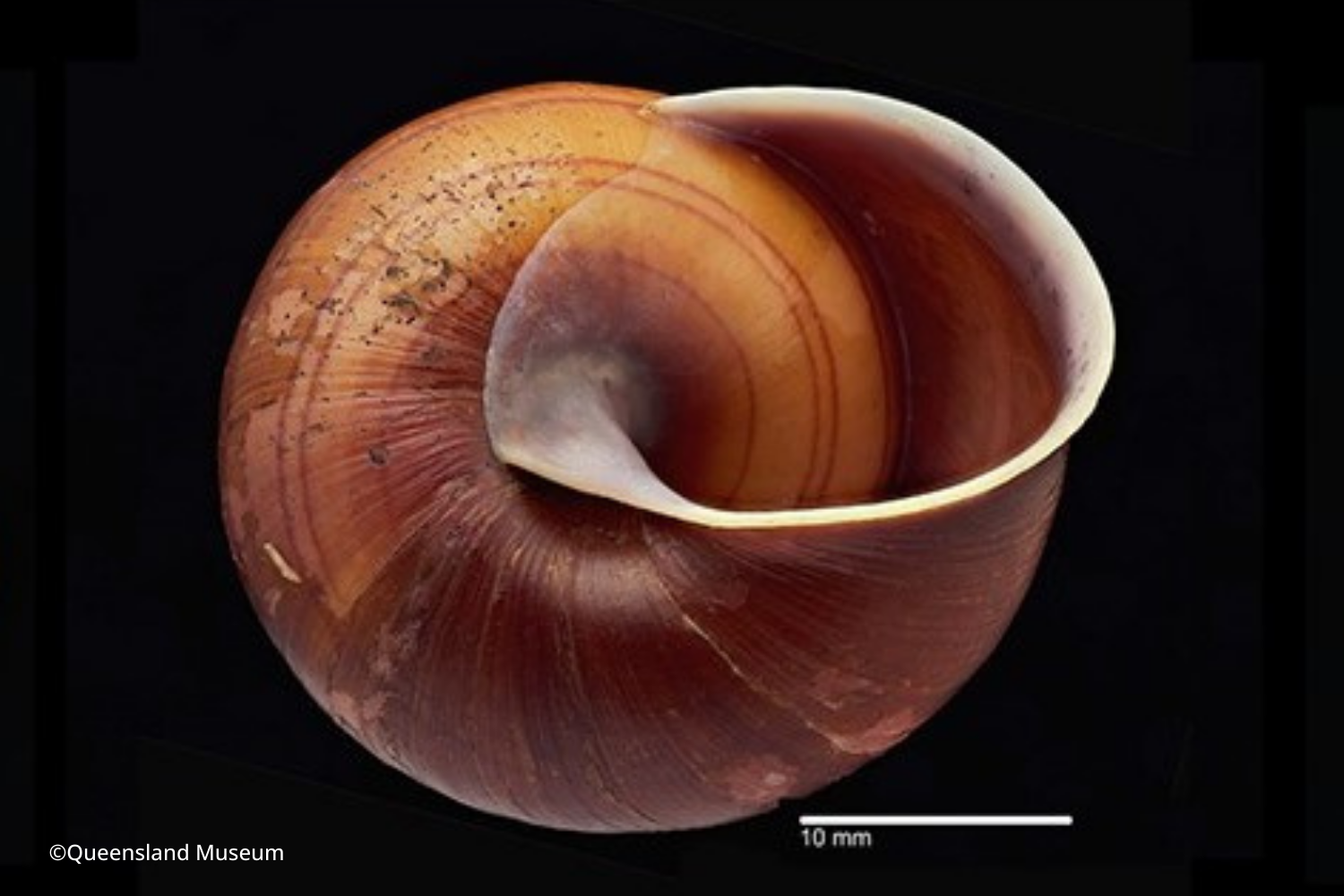Four new-to-science species of snail described

DNA analysis by Queensland Museum scientists has unearthed the true identity of 15 species of land snails including four new-to-science species with one named in honour of Queensland wildlife warrior Robert Irwin.
For the past four decades, taxonomists have been confused by the Figuladra group of snails, whose shells were used as the primary form of species identification and now Queensland Museum Honoraries Dr Lorelle Stanisic and Dr John Stanisic OAM have unlocked the mysteries of these species through DNA analysis alongside Australian Museum’s Dr Frank Köhler.
Dr John Stanisic said the Figuladra group of snails are highly variable in shell characters, such as colour and banding pattern, making the species difficult to tell apart on their shells alone and why DNA was crucial.
“Lorelle’s study was primarily based on more than 270 dissections of reproductive structures and DNA analyses of animal tissue from which she was finally able to determine the true identity of 15 species,” Dr John Stanisic said.
“Four of these were new-to-science species including Robert Irwin’s Banded Snail, Figuladra robertirwini.”
The species of Figuladra are found in dry vine thicket from just north of the Mary River in South East Queensland to south of the O’Connell River near Proserpine in North Queensland.
One of the species, the Bundaberg Banded Snail (Figuladra vidulus), is colloquially known as the ‘suitcase snail’ due to the scientists finding large numbers in a discarded suitcase in vine thicket on the Hummock, west of Bargara, Queensland.
Dr Lorelle Stanisic said land snails are important environmental indicators and biodiversity predictors.
“Land snails generally coexist with other invertebrates and the destruction of their habitat affects what I would consider the hidden engine room of our forests. Land snail conservation should be a high priority,” Dr Lorelle Stanisic said.
Queensland Museum CEO Dr Jim Thompson said the work of Queensland Museum scientists were wide and varied in the field of taxonomy.
“The field and research of malacology in Australia is a crucial study as the research undertaken into these molluscs can provide insights in the management and conservation of forests,” Dr Thompson said.
“I commend the work of Queensland Museum researchers such as John and Lorelle Stanisic, whose taxonomic research contributes to the overall understanding of Australia’s fauna.”
Figuladra finlaysoni
Etymology: Named for Hector Mackenzie Finlayson, an early settler of the Seaforth area.
Preferred common name: Seaforth Banded Snail.
Shell colour and pattern variation: Shell tawny yellow to light brown with prominent broad subsutural and supra-peripheral bands, numerous narrower dark brown spiral bands continuous on base and a brown suffusion on last half of body whorl (most populations).
Distribution and habitat: From Pine Mt via Nebo in the west, east to the northern part of the Connors Range west of Funnel Creek (Blue Mountains); coastally from south of Sarina to Mackay and north to Seaforth and St Helen’s Beach, MEQ; in coastal semi-evergreen vine thicket and microphyll vine forest; living under timber, in hollow trees, palm fronds and under rocks and the bark of standing trees.
Key localities: Pine Mt via Nebo, Blue Mountains, Eton, Slade Point, Finlayson Point, St Helens Beach.
Figuladra robertirwini
Etymology: Named for Robert Irwin, conservationist and wildlife photographer, Australia Zoo.
Preferred common name: Robert Irwin’s Banded Snail
Shell colour and pattern variation: Shell with variable colour forms: tawny yellow with thin brown banding, prominent brown supra-peripheral and subsutural bands generally present, brown suffusion behind the lip and on lower half of body whorl and surrounding umbilicus. Monochrome brown to dark brown; shells at Eurimbula NP, SEQ with paler spire. Shells with a pale base occur at Bustard Head, SEQ. Based on 73 measured adult specimens.
Distribution and habitat: North of the Kolan River to Rodds Peninsula and west to the Many Peaks Range (Bobby Range), SEQ.
Key localities: Turkey Beach area, Rodds Peninsula, Granite Ck, Colosseum Ck, Eurimbula NP, Bulburin SF.
Figuladra bromileyorum
Etymology: Named for the Bromiley family, Lorelle Stanisic father’s family who were early settlers in the nineteenth century in the Hervey Bay area and well known for farming coffee, sugar cane, pineapples and timber.
Preferred common name: Dundowran Banded Snail
Shell colour and pattern variation: Shell light to dark brown with orange-brown banding and paler spire; prominent dark subsutural band and numerous thinner dark brown bands; brown suffusion behind the lip and surrounding the umbilicus; occasionally with extensive brown suffusion on body whorl; some specimens from Poona and Fraser Island, SEQ are monochrome dark brown without any trace of banding.
Distribution and habitat: Hervey Bay region south of the Isis River to Inskip Point including Fraser Island, west to Aramara SF, SEQ; in vine thicket living under and inside logs, under rocks and under the bark of trees.
Key localities: Dundowran Beach, Fraser Id, Aramara SF, Pialba and Poona.
Figuladra vidulus
Etymology: From the Latin vidulus = suitcase, noun in apposition referring to a community of these snails that were found surviving in large numbers in an old, abandoned suitcase in the vine thickets of The Hummock, SEQ.
Preferred common name: Bundaberg Banded Snail.
Shell colour and pattern variation: Shell tawny yellow to brown with paler spire and darker brown banding; broad brown subsutural and narrower supra-peripheral bands; brown suffusion behind the lip and surrounding the umbilicus. Monochrome brown specimens occur at some localities.
Distribution and habitat: Coastal and sub-coastal lowlands of the Bundaberg region between Kolan River and the Isis River, SEQ; in semi-evergreen vine thicket, living under and inside logs and under rocks.
Key localities: The Hummock, Bagara, Norval Park, Woodgate NP.

 China
China